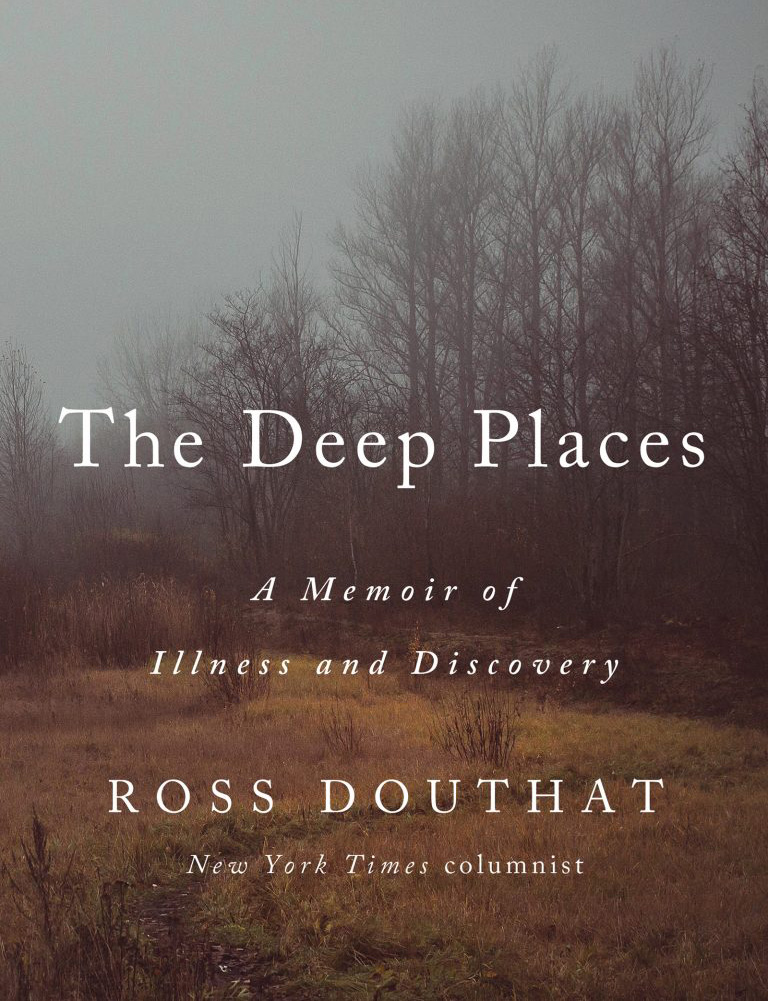“Deep Places” Explores One Man’s Lyme Fight Author Ross Douthat shares how his life changed dramatically.
R oss Douthat was a busy man. In addition to his regular opinion column in the New York Times, he wrote books, gave speeches, traveled, interviewed people, and was often interviewed himself.
 In 2015, he and his wife had two kids and another on the way. They decided to leave Washington DC and relocate to Connecticut, where they had both grown up and still had family.
In 2015, he and his wife had two kids and another on the way. They decided to leave Washington DC and relocate to Connecticut, where they had both grown up and still had family.
They found a rambling old country house that they fell in love with. After walking through the dwelling and briefly strolling around the property surrounding it, they made an offer which was accepted. Then, they returned to DC to prepare for the move.
And that’s when Douthat’s life changed dramatically.
It started with a stiff neck and an enlarged lymph node. (“Nothing to worry about,” said an internist.) It progressed to migrating pain that moved from his head to his spine to his chest to his arms and legs. (“Maybe drink more Gatorade–for the electrolytes,” suggested a neurologist.) Other specialists prescribed sleeping pills and antidepressants. (“Stress,” they declared. “Too much going on in your life.”)
The Reason or the Symptom?
“I did feel stressed,” Douthat remembers. “But the illness felt like the reason rather than the symptom.”

He was tested for Lyme disease a couple of times, with negative results.
Meanwhile, the bizarre symptoms continued. Before he and his family left Washington, crushing chest pain sent him to the emergency room on two different occasions. Doctors there found nothing wrong with him. He followed up with various specialists, who theorized that his symptoms were psychosomatic.
As one infectious diseases doctor put it: “Look, I know it’s hard to see, but you should feel happy. It’s a good thing not to have a disease, you know…. And, if you need a mental health referral, we can definitely help with that.”
Caught in the Middle
In his recently published book, The Deep Places: A Memoir of Illness and Discovery, Douthat writes about being caught between what he was feeling in his body and what the doctors confidently proclaimed didn’t exist.
By this point, I was deep into self-doubt about the reality of my experience. On the one hand, there was the pain, the burning, the vibrations, the feeling of invasion; I knew I’d never felt anything like this before. But what were mere feelings set against the certainties of so many doctors, the repeated negative readings of my blood?
The family moved to the big country house, Douthat’s condition continued to deteriorate, and he consulted new doctors in Connecticut.
First stop was a psychiatrist, who listened, took notes, and then surprised Douthat by saying, “I’m pretty sure you have a tick-borne disease, Ross.” (Had a tick nailed him during his initial inspection of the Connecticut property? The timing certainly seemed right.)
This sent him in search of Lyme specialists and to dig even deeper into learning about the illness: the problematic testing, difficulty of diagnosis, controversial treatments, and how mainstream medicine looks at Lyme with a mixture of disdain and denial.
Frustrating Illogic
He notes the frustrating illogic that Lyme patients face:
If you were a positive case with lingering, persistent symptoms after treatment, then your Lyme officially belonged to the past, and you no longer had a CDC-recognized disease. Instead, you had something called Post-Treatment Lyme Disease Syndrome (PTLDS), and the CDC’s advice for anyone suffering through it was to basically keep on suffering.
And he wonders:
If someone has an illness, takes a drug to treat it, and afterward retains exactly the same symptoms, why wouldn’t you assume that they have simply continued to have the same disease? Why invent a mysterious “post-disease syndrome” to explain what is experienced by the patient as one continuous sickness?
Douthat consulted different Lyme specialists that prescribed various antibiotic combinations. Some helped in some ways—but nothing got to the heart of the matter. He was still desperately ill.
At that point, Douthat started branching out into more alternative realms such as muscle testing, magnets, and a Rife machine—along with continuous heavy-duty prayer—and by the close of 2019, he was doing much better. “2020, I told myself, is going to be a good year.”
Then he and other family members got nasty cases of COVID. And he writes:
The coronavirus era soon came to feel like a shattered mirror of the tick-borne epidemic and its controversies, with different pieces of the Lyme wars reflected and refracted in different aspects of the world-wide COVID crisis.
Author: Ross Douthat
I’ve read and reviewed a lot of books about Lyme disease. Douthat’s book is one of the best. I highly recommend it.
In the following excerpt of “The Deep Places”,
Douthat expands on this comparison between Lyme disease and COVID-19.
The most direct parallel between the Lyme experience and the coronavirus drama, though, was in the swift proliferation of chronic cases from the new disease. These were the people, usually younger than the fatal cases, who got sick and didn’t die but didn’t seem to get better, either. They spent months bedridden and exhausted, they ran fevers that didn’t break, they reported effects from the sickness not just in their throat or lungs but all over, in the heart and kidneys, joints and muscles, bowels and brain.
After months of illness, a female colleague, younger than me and doubtless healthier, still couldn’t walk more than two blocks without pausing, short of breath. One of my college roommates who lived in Queens was sick for three weeks in March and seemed to quickly recover, only to find himself plagued by recurring chest pain, more in the heart than in the lungs, which sent him—like me, five years earlier—to emergency rooms and cardiologists with no result. When a New Yorker named Hannah Davis passed her four-month mark after infection, in late July of 2020, she tweeted a list of symptoms that reminded me of the letters that desperate Lyme patients sent to Allen Steere in the 1990s, begging to be taken seriously:
I still have a near-daily fever, loss of cognitive function, essential tremors, GI issues, severe headaches, heartrate of 150+, viral arthritis, heart palpitations, muscle aches, a feeling like my body has forgotten to breathe. Over the past 124 days I’ve lost all feeling in my arms & hands, had extreme back/kidney/rib pain, phantom smells (like someone BBQing bad meat), tinnitus, difficulty understanding text/reading, difficulty following conversations, sensitivity to noise & light, nonstop bruising. *Thinking* can cause headaches now.
Nobody knew exactly what to do for these “long-haul” COVID patients, and, as with Lyme patients there were plenty of stories about sufferers being dismissed and disbelieved, especially in cases where they had tested negative or (often, in those days) simply been unable to get a test to confirm their diagnosis.
At the same time, though, the scope and speed of COVID’s airborne spread, the fact that there were so many of these long-haul patients all at once, seemed to create more sympathy and straightforward belief for their stories than in the slower-building tick-borne epidemic. So, perhaps, did the fact that doctors and nurses were disproportionately represented among early COVID cases, and thus among long-haulers, too.
In October of 2020, The Wall Street Journal covered some of these doctors, many of them months into a twilight existence of chronic fatigue and heart palpitations and headaches. One of them, just two years removed from running the New York City Marathon, described going to a pulmonologist for her racing heartbeat and being told to try psychiatry and Xanax: “I said, ‘I don’t think so, I’m a psychiatrist.’” Another, an emergency physician in Atlanta, told the Journal that “this has absolutely changed my perspective . . . [on] the patients I see who come in with symptoms that are very real and I can’t find any objective data to point me to a certain diagnosis.”
So COVID offered a terrible crash-course education in the reality of chronic illness, the gap between what a disease was supposed to do in its “normal” presentation (symptoms in the throat and lungs for the coronavirus, a bull’s-eye rash and fever and joint pain for Lyme) and how often the actual presentation is something else entirely, how many weird cascades a single invader can set off, how easily a previously healthy person can fall into a pit.
Who knows whether this education will change the way chronic illnesses are treated in the long run. Much of the medical theorizing about long-haul COVID, so far, has followed tracks familiar to Lyme patients—treating the recurring symptoms as problems of inflammation and tissue damage, a disturbed autonomic nervous system or an autoimmune cascade, which need to be managed palliatively or suppressed while the body is trained back to health through exercise or just recovers on its own.
For patients who don’t seem to make much progress, there are grim comparisons to chronic fatigue syndrome, fibromyalgia, and, yes, “post-treatment” Lyme—but as with official discussions of those conditions, the possibility that a pathogen lingers is downplayed, and the assumption is that most of the suffering are fully in the aftermath of their infection.
Patience may well be the right approach for a lot of long-haul cases, who do seem to improve just by gradually building up their strength, slowly extending themselves in exercise as their hearts and lungs get back to normal. My colleague’s case has been like that, and maybe my mother’s as well: She feels okay six months after falling ill but gets chest pain and exhaustion when she does too much yard work.
On the other hand, people like Hannah Davis who have symptoms that seem to pop up randomly around the body, with kidney pain one day and neuropathies the next and brain fog all the while—it seems an awful lot like the way Lyme and other tick-borne travelers persist inside afflicted flesh, their effects cropping up all over long after the acute initial phase is done.
A virus is not a burrowing spirochete, but we know that viral infections, too, can persist and reappear. In the case of chronic fatigue syndrome, for instance, some doctors believe that the Epstein-Barr virus, often the triggering pathogen, sticks around to cause the ongoing immune disturbances, much as COVID-19 might in long-haul patients.
So to hear the term “post-COVID syndrome” already being tossed around to describe people whose COVID experience feels continuous, just months and months of the same feelings the virus gave them from the start—well, let’s just say it sounds unfortunately familiar, and not necessarily a good sign for bringing them fully back to health.
Prominent Deniers of Chronic Lyme
Shortly after publication of his book, Douthat published three articles in the New York Times that drew upon his Lyme experiences.
Author: Ross Douthat – Publication: New York Times – Date: Oct. 24, 2021
Author: Ross Douthat – Publication: New York Times – Date: Oct. 31, 2021
Author: Ross Douthat – Publication: New York Times – Date: Nov. 7, 2021
On November 27, 2021, the newspaper published seven letters to the editor in response to Douthat’s trio of articles. Three of the letter writers are prominent IDSA members, all well known deniers of chronic Lyme. Another one consults for Big Pharma. Any guesses about what those guys had to say about Douthat’s columns?
Editor’s note: Any medical information included is based on a personal experience. For questions or concerns regarding health, please consult a doctor or medical professional.






























